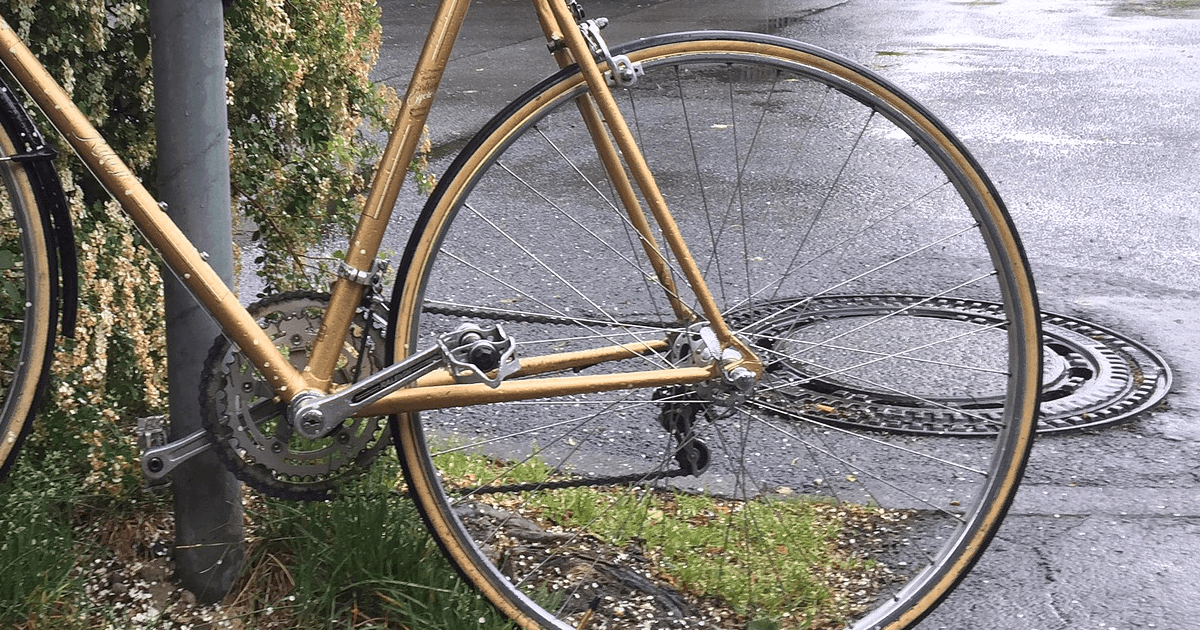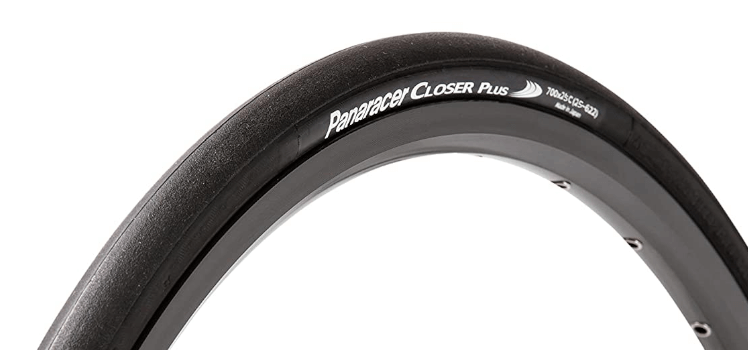Overview and Specifications of WheelTop's Affordable Electronic Groupset "EDS"
This article summarizes the features and specifications of the budget-friendly electronic groupset "EDS" newly released by the Chinese manufacturer WheelTop.
Posted at: Feb 13, 2022
Road bikes are often used for riding in the rain. In this article, we summarize tire selection for riding in the rain on a road bike.

Table of contents
Sponsored Link

Wearing slick tires without grooves on a rainy day gives the image of slipping, but this is because it is associated with a phenomenon called “hydroplane” that can cause loss of control.
However, hydroplaning is a phenomenon that tends to occur when cars are riding at high speeds on highways, so if you are riding a bicycle at normal speeds, you should have no problem wearing slick tires on a rainy day.
On the other hand, the road surface is still slippery on a rainy day.
Therefore, it is a good idea to keep the tire pressure lower than usual so that the tires can grip the road. Lower tire pressure increases the grip and prevents you from falling due to driving errors.
Even professional road teams lower the air pressure of their entire team’s road bikes when the road surface is wet, and this wisdom should be used by hobby riders as well.
Since road bikes are designed for high-speed cruising, they are usually equipped with narrow tires such as 25C or 23C. If you are cycling or training, you can choose not to go if it is raining, which is fine, but if you are commuting to work or school, it is hard to choose not to go.
If it should rain on the way to work or school, or if you need to ride your road bike to work or school even on a rainy day, you should wear larger tires (28C or larger) so that you have more grip even when it rains.
In the past, thicker tires were thought to be heavier and slower, but today’s tires for road bikes weigh only about 50g between 23C and 28C for the higher grades. For example, for Panaracer’s Race A Evo4, there is only a 40g difference between the 23C tire (200g) and the 28C tire (240g).
It is said that even a 100g weight reduction is important for a road bike, but for commuting purposes, a 100g difference between the front and rear tires is hardly noticeable.
Of course it is important to choose the right tires for a rainy day, but it is said that driving skill is even more important.
The following four points are important to keep in mind on rainy days. 1.
Do not brake at manholes or white lines. Always anticipate danger. Don’t drive too fast. Always follow the traffic rules more strictly than usual.
If you are late, you can always start over, but if you are in a traffic accident, you may not be able to start over.
Tires and other equipment are important, but the most important thing is to remember to drive safely.
Sponsored Link
Choosing the right tires for a rainy road bike ride
Road bikes are often used for riding in the rain. In this article, we summarize tire selection for riding in the rain on a road bike.
Tire Tubes: Types, Manufacturers, and Selection Tips
Tire tubes are consumable parts that are replaced relatively frequently on bicycles. We have compiled a list of tire tube types, manufacturers, and points to keep in mind when selecting a tire tube.
Properly Inflating Bicycle Tires: The Importance
Tire air maintenance is surprisingly often neglected, but in fact, it is only beneficial. In this issue, we summarize the importance of keeping tires well inflated and the precautions to take when inflating tires.
Road Bike Tires: Types and How to Enjoy Them
Changing tires can change the way you ride! We have compiled a list of different types of tires for road bikes, their respective characteristics, advantages and disadvantages, and how changing tires can make road biking more enjoyable.
Changing Bicycle Tire Size and Thickness: 3 Key Points
Tire customization is a fun way to change the riding experience for a cost of about $100. When replacing tires, there are three points to keep in mind when changing the size and thickness of your bicycle tires.
Bicycle Tire Lifespan: Tips to Extend and Check for Wear
This section summarizes the life of a typical bicycle tire, how to check for wear and tear, and how to replace a tire. Also how to store tires to extend their life.
Road Bike Tire Names, Sizes, and Standards
There are many different types of tires for road bikes, including different size standards and types. In this issue, we summarize the key points you should know about road bike tires.
Advantages and disadvantages of clincher tires
Clincher tires are widely used on bicycles, from city bikes to road bikes and other sports bikes. The following is a summary of their advantages and disadvantages.
Advantages and disadvantages of tubular tires
Tubular tires are the choice of users who are concerned about performance. In this issue, we summarize the advantages and disadvantages of tubular tires and what kind of users they match.
Tubeless and Tubeless Ready Tires: Pros and Cons
Tubeless and tubeless ready tires are increasingly being adopted in the latest wheels. The following is a summary of the differences, advantages and disadvantages of each, and points to keep in mind when choosing.
TPU Inner Tube: Features, Pros, and Cons for Road Bikes and MTB
TPU inner tubes are gaining attention as the third force in bicycle tires. We summarize its features, advantages and disadvantages of using it on Road bikes and MTBs, and major manufacturers.
Overview and Specifications of WheelTop's Affordable Electronic Groupset "EDS"
This article summarizes the features and specifications of the budget-friendly electronic groupset "EDS" newly released by the Chinese manufacturer WheelTop.
What Is Shimano Shadow RD? Features and Benefits
What is Shimano’s Shadow RD used in their latest rear derailleurs? This article explains its features and the benefits of choosing Shadow RD.
[MTB / Hybrid Bike] Hydraulic Brake Manufacturers for Flat Bars
An overview of manufacturers that produce hydraulic brakes for flat-bar MTB and hybrid bikes, along with their key features. Also includes tips on how to choose the right flat-bar hydraulic brake brand.
Shimano Chain Compatibility for Road, MTB, and Hybrid Bikes
An overview of Shimano chain compatibility across road bikes, mountain bikes, and hybrid bikes. Includes guidance on how to choose the right chain for your drivetrain.
Shimano ESSA Lineup and Compatibility with Existing 8-Speed Parts
An overview of Shimano's newly released 8-speed component group "ESSA" and its compatibility with existing 8-speed parts.
SRAM Cassette Compatibility Guide
Compatibility guide for SRAM cassettes used in road and MTB bikes. Find matching drivetrains and wheels easily.
Compatibility Guide for SRAM MTB Components
A detailed explanation of compatibility between SRAM MTB components. This guide outlines which parts can be used together and which combinations are not compatible.
Road and MTB Sprockets Compatibility Overview
A guide to the compatibility between road and MTB sprockets, explaining whether they can be used together with different components.
Types of Shimano Di2 Tools and Their Compatibility
A guide to the essential Shimano Di2-specific tools, especially the "plug tools" used for connecting components, and their compatibility with various Di2 parts.
Shimano CUES Cassette Compatibility Guide
A detailed guide to the compatibility of Shimano CUES series cassettes. Includes an overview of compatible rear derailleurs, chains, and wheels.
Shimano Hydraulic Brake Hose and Connector Standards Guide
An explanation of the differences between Shimano’s hydraulic brake hoses BH90 and BH59, the types of connecting bolts, and how to choose the right hose for your brake system—including key points to watch out for.
[By Manufacturer] Types, Features, Pros and Cons of Hydraulic Brake Oils
This article explains the types of hydraulic oils used in bicycle hydraulic brakes, their characteristics, and the brake oil types used by each manufacturer.
Types and Compatibility of Shimano Di2 Batteries
The Di2 battery is the core of the Shimano Di2 system, influencing the overall system layout. This article explains the different types and their compatibility.
Shimano Di2 Wire Types and Compatibility
Overview of Shimano Di2 electric wire types and their compatibility with Di2 components.
How to Identify Shimano Di2 Generations
Explains the generational differences in Shimano Di2 components and their compatibility. Includes a list of component series and their corresponding generations.
In-Depth Guide to Shimano 12-Speed Cassette Compatibility
A detailed explanation of the key compatibility factors when using Shimano's 12-speed cassettes—specifically the required wheel (freehub) and drivetrain, which differ significantly from previous 11-speed systems.
Perfect Guide to Shimano 11-Speed Cassette Compatibility
A detailed explanation of two key compatibility factors when using Shimano 11-speed cassettes: the required wheel (freehub) and drivetrain.
Perfect Guide to Shimano 10-Speed Cassette Compatibility
A detailed explanation of two key compatibility factors when using Shimano 10-speed cassettes: the required wheel (freehub) and drivetrain.
In-Depth Guide to Shimano 9-Speed Cassette Compatibility
A comprehensive explanation of two key compatibility factors when using Shimano 9-speed cassettes: the required wheel (freehub) and drivetrain.
What Is a BOOST Crank? Differences from Standard MTB Cranks and How to Choose
This article explains what a BOOST crank is, how it differs from conventional MTB cranks, and provides guidance on selection across different manufacturers.